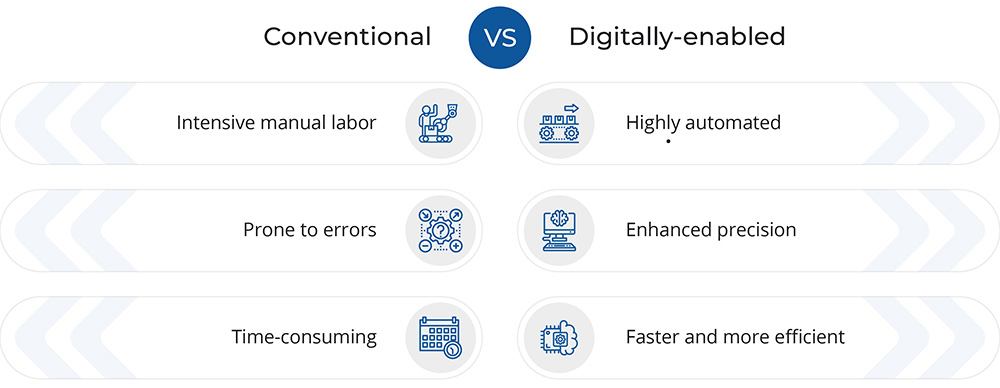AT A GLANCE
- Pharmaceutical research and development is steadily going on the path of digitization and the companies that can leverage this digital transformation will be ahead in the curve.
- RD digital transformation is not a goal; instead, it is a journey wherein companies would need to strategize their moves for an effective result in terms of cost reduction and manage quality criteria of the medicine.
- RD constitutes a significant portion of pharmaceutical expenses and by automating, optimizing, and expediting processes through digital technology, pharma companies can turn the corner and get better outcomes of the research.
The pharmaceutical industry relies on RD and clinical research for drug development and efficacy testing. The core of pharma operations lies in the research that goes behind formulating, testing, developing and researching a drug. That’s the reason that the RD costs in the pharmaceutical industry are in the higher stratum. Companies, both large and small, are searching for one answer- how to reduce cost in the pharma industry? Many experts believe that they need to start with RD digital transformation in pharma companies. This will not only effectively cut down the excess costs but will also save time and labor.
While going digital is inevitable, many pharmaceutical companies are not yet fully equipped to undergo this change. Even today’s clinical trials have changed, and the pharmaceutical industry needs to cater to this rather personalized, targeted healthcare system. By adopting digital tools and artificial intelligence for faster and more accurate RD, Pharmaceutical companies can achieve much-needed improvement in tracking test results and performing trending and analysis. Digitized systems also help save pharmaceutical research and development costs by reducing the human effort and error rate in extrapolating the data to adjust ingredients better while producing samples.
According to Investopedia, pharmaceutical companies spend, on average, 17% of revenues on research and development (RD), making it one of the biggest spenders in this area.
So it is essential to look at some of the ways pharmaceutical and life sciences companies can leverage the latest digital tools and technologies to minimize expenses and maximize RD efficiency.
5 Digital Strategies for Pharmaceutical Research and Development
1.Leveraging Artificial Intelligence for Identifying Drug Molecule:Identifying a drug molecule for a particular ailment and synthesizing it can take years of research and trials in the lab. However, scientists can run data through systems and identify the potential molecule/s and their plausible effective dosage within a short time with artificial intelligence. AI tools can also help devise the chemical formula and method of synthesis for these molecules to be synthesized entirely from scratch in a laboratory under controlled settings.
2.Using Predictive Analytics for Drug Discovery and Development:Like AI tools, predictive analytics software can be a boon for scientists looking to cut down pharmaceutical expenses and improve their outcomes. With predictive analysis, scientists get to know how a particular molecule or combination of different ones behave in the drug, how long they will take to be effective, and what percentage of ingredients will impact the drug’s potency and life. This will help in deciding drug dosage, its schedule and efficacy.
3.Streamlining Drug’s Regulatory Timeline:Pharmaceutical RD works in close collaboration with the regulatory bodies to get the drug formulations approved. This involves much paperwork, which calls for time and effort. Digitization can easily create efficient methods of running operations without compromising regulatory requirements. Automated workflows will avoid slowing down your progress and expedite your ability to go to market.
FIGURE 1:Pharma RD: Digital Transformation Elements

4.More Efficient Selection of Volunteers/ Patients for Clinical Trials:The current Covid-19 pandemic has seen clinical trials at a break-neck speed and a large scale across various countries globally. Such speed and scale would not have been possible without leveraging digital technologies to select the most appropriate candidates for the trials. Digital databases can also analyze and prepare best-matched trial samples of the patients to represent diverse age-groups, ethnicities and even people from various socio-economic backgrounds. Such a varied and well-matched selection can yield better and more all-encompassing results.
5.Bridging the gap between pharmaceutical RD and academia:RD and academia go hand-in-hand. However, the lack of correct avenues has created a gap between these two research bodies. This data (non-confidential) can easily be made available to academic institutes and even research organizations for further insights and value generation with digitization.
Apart from these strategies, pharmaceutical companies can also leverage digital technologies to streamline their supply chain and optimize operations to effectively support their RD. The RD digital transformation journey is not an easy one as it has many challenges and setbacks. However, pharma companies must keep in mind that the long-term benefits of digitization strategies are plenty. With the right roadmap, pharmaceutical RD can become less resource/ revenue-intensive yet more effective in terms of outcomes.
Key Takeaways
- While pharmaceutical companies are keen on applying digital technologies, there needs to be a strategy in place for effective implementation as per the companies’ customized requirements.
- Pharma executives and decision-makers will need to look at digitization as an ongoing journey and prepare themselves for internal resistance, technical challenges and more.
- Going digital is indeed the need of the hour, and pharma companies need to strategize their RD infrastructure accordingly.







